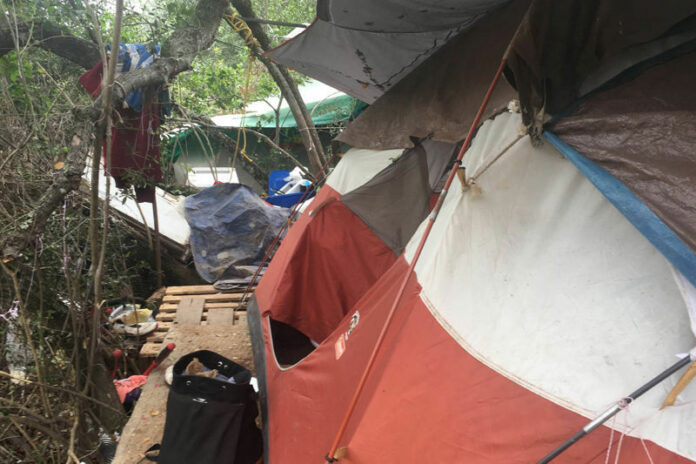
After seven-year decline, homeless numbers jump by 6 percent
After a seven-year decline in the county’s prevalence of homelessness, data from the 2018 homeless count shows homelessness is once again on the rise.
According to the 2018 Sonoma County Point-in-Time Count, the homeless population increased by six percent, leaving 161 additional people to sleep on the streets, in vehicles, in encampments, in abandoned buildings or in shelters.
County Community Development Commission officials attribute the rise in part to the housing shortage following the October firestorm and expect the numbers to increase.
“We anticipate a wave of more homeless populations,” said Felicity Gasser, Policy and Communications Liaison for the CDC.
In order to have more access to state resources, the county board of supervisors declared the county in a “homeless state of emergency” by request of the CDC during a July 10 meeting.
Gasser said she anticipates the state of emergency will help the county access approximately $12 million in one-time funds.
“While some of this will go into augmenting emergency shelter and assistance programs, we hope that much of these resources will be directed into building more permanent, supportive housing, as the lack of access to affordable and stable homes is the most prevalent cause of homelessness in our community,” she said.
Colleen Carmichael, Executive Director at Reach For Home, said she agrees the fires and the lack of affordable housing impacted the prevalence of homelessness in north county, but they were not the only factors. “It’s also about affordable housing versus amount of income,” she said.
Reach for Home is a nonprofit organization offering programs to provide opportunities and support for clients to work toward self-sufficiency, independence and permanent housing. The organization serves clients who live in Windsor, Healdsburg, Cloverdale and Geyserville.
Carmichael said the organization has seen a noticeable increase in new faces as well as an increase in those in danger of becoming homeless. The aftermath of the October fires continues to be spread into further reaches of the county.
“Now they are starting to be visible,” she said. “This ripple effect is going out to north and west counties,” she said.
The count
The annual homeless count is required by the Department of Housing and Urban Development for the county to be eligible for $3.4 million in annual homeless services. Carmichael said that money, as well as funding through grants and other charitable organizations, is absolutely crucial to provide services in the county.
Statistics on the homeless population are gathered through the annual county point-in-time count handled by the Community Development Commission.
The 2018 Sonoma Homeless Point-in-Time Census and Survey was done in collaboration with Applied Survey Research, a social research firm that has worked with county on their point-in-time Counts since 2009.
According to HUD standards, the definition of homelessness includes individuals and families living in a supervised publicly or privately operated shelter designated to provide temporary living arrangement; or with a primary nighttime residence that is a public or private place not designed for or ordinarily used as a regular sleeping accommodation for human beings, including a car, park, abandoned building, bus or train station, airport, or campground.
A team comprised of 69 individuals with firsthand experience of homelessness, 108 community volunteers, staff from city and county departments and law enforcement canvassed the entire county between the hours of 6 and 10 a.m. on February 23.
The survey placed teams on foot and in vehicles to locate people experiencing homelessness throughout city and rural areas of the county. Another way the data was gathered was through a follow-up survey administered to 519 unsheltered and sheltered homeless individuals to profile their experience and characteristics.
In addition, a specialized count of unaccompanied children and youth under the age of 25 was conducted the same day.
Changes
Gasser said for the first time the commission’s homeless count consultants conducted a telephone survey to learn about people who are living in unstable situations. The survey found that approximately 21,400 residents are living in unstable housing situations.
“These are people who are couch surfing or doubled up, or who have no lease,” she said. “The homeless count, along with the telephone survey, suggest a new wave of people are already becoming homeless as they exhaust their resources following the fires.”
The numbers
The following statistics were taken from the homeless census and survey;
2,996 homeless people were found.
64 percent were unsheltered.
38 percent lived on the streets or in encampments, 24 percent in vehicles, and 4 percent in abandoned buildings.
56 percent were homeless for a year or more, 34 percent were homeless for 1-11 months, and 10 percent were homeless for 30 days or less.
35 percent were experiencing homelessness for the first time.
19 percent had experience in foster care.
34 percent had been physically, emotionally or sexually abused.
20 percent identified as LGBTQ.
84 percent lived in Sonoma County before becoming homeless.
72 percent cited affordable rent as the primary obstacle in obtaining permanent housing.
64 percent reported living with one or more health conditions.
The number of chronically homeless people increased from 598 in 2017 to 747 in 2018.
Breakdown
By far, the largest age group identified as homeless is in the 25-54 age range, making up 62 percent of the homeless population. Young adults ages 18-24 represent 16 percent of the population followed closely by senior adults (55 and older) at 14 percent. Youth under 18 make up 8 percent of the homeless population.
Men represent 58 percent of the homeless population, while women make up 39 percent. Transgender homeless make up 2 percent followed by nonconforming gender people who make up 1 percent.
A bulk of the homeless population, 62 percent, is made up of people who identify as white. The second largest group at 21 percent is multi-racial.








